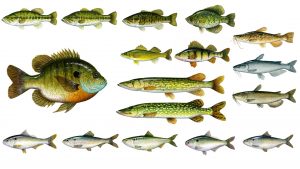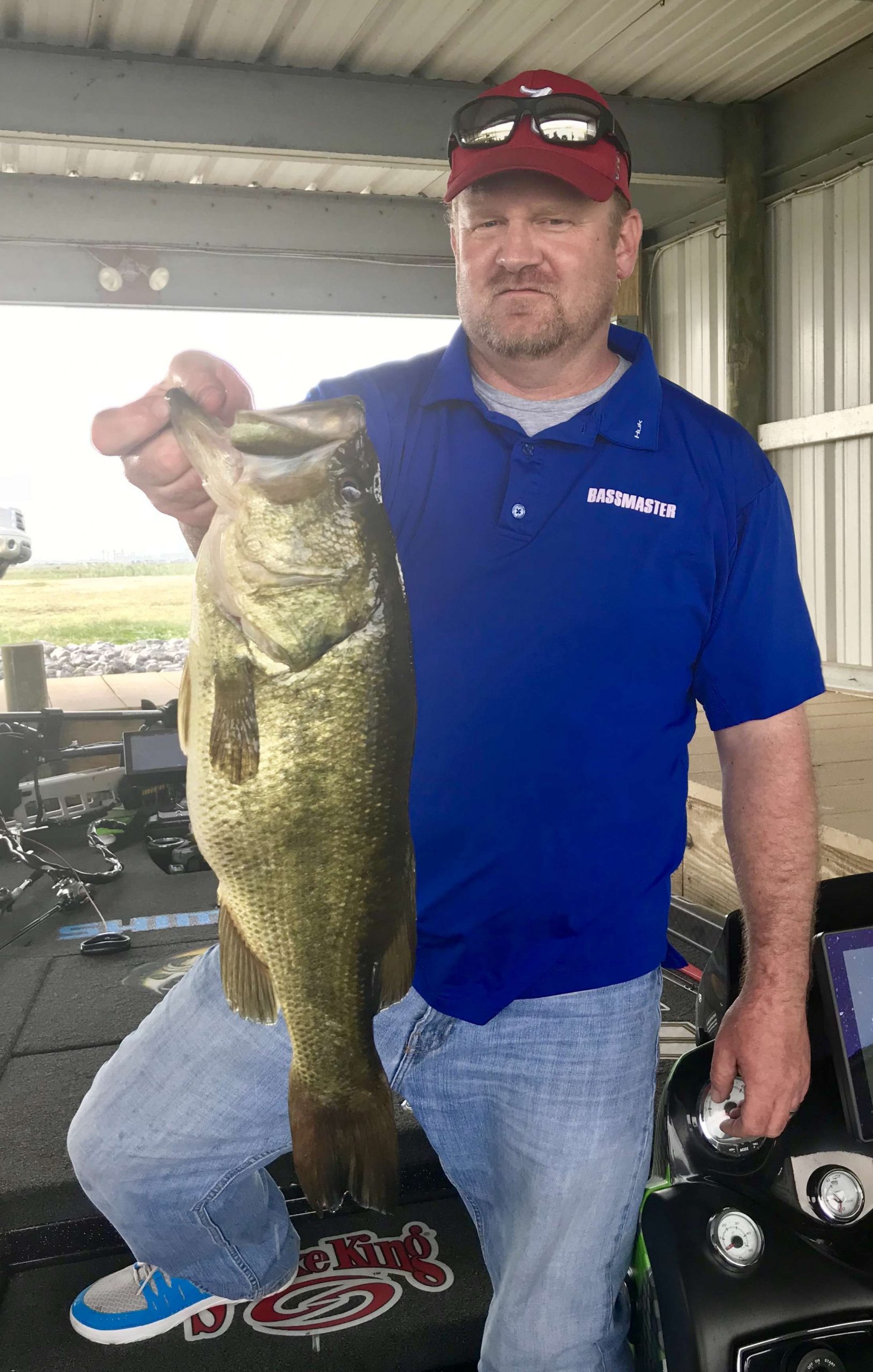

Alewife
A prized baitfish, the alewife is a thin, silver fish with grayish-green back, smooth scales and large eyes. Adults grow up to 15 inches and weigh less than one pound. They are found in 22 states, mostly east of the Mississippi River. (Jonathan H Milo)

Threadfin Shad
Threadfin shad are a common silver-sided baitfish species native to the United States west of the Appalachian Mountains. Since they are extremely sensitive to cold water, they often do not occur in lakes that ice over for the winter. They are often stocked into ponds and lakes in warm environments because they reproduce quickly and provide excellent food for larger predator fish. (Jonathan H. Milo)

Hickory Shad
The hickory shad has a thin, grayish-green body with an iridescent silver belly and sides. It has a dark spot on its shoulder followed by several fainter spots. It is distributed along the Atlantic coast, historically as far north as the Bay of Fundy to the Tomoka River in Florida. (Jonathan H. Milo)

Gizzard Shad
The American gizzard shad has a deep body, with a silvery-green coloration on top fading to plain silver coloration on its belly. They are found in the Southern Great Lakes Region, Mississippi River basin, Atlantic region and Gulf Slope drainages from Quebec to central North Dakota and New Mexico, and south to central Florida and Mexico. It largely valued as a forage fish for larger predators like largemouth bass. (Jonathan H. Milo)

Blueback Herring
One of the larger baitfish species, the blueback herring is silvery in color and is characterized by its deep bluish-green back. They are native to only 13 states, but have been illegally introduced into many reservoirs to improve the size of many predators, most often the spotted bass. (Jonathan H. Milo)

Pickerel
Often confused for the northern pike, the chain pickerel is similar in appearance but grows much smaller. They range from the St. Lawrence River drainage south to Florida, east of the Appalachian Mountains. They are also found in the southern Mississippi drainage. They are particularly common in lakes with lots of aquatic vegetation. (Jonathan H. Milo)

Pike
Occurring mostly in northern fisheries, the pike is a large fish with an elongated body and scales that have a dark greenish-brown coloration. They have light-colored spots on their sides and a mouthful of sharp teeth. Most measure about 18 – 20 inches long and weigh 1 – 2 pounds, but they have been known to reach weights up to 60 pounds. Though many people fish for them intentionally, they are a common “accidental catch” while fishing for other species like bass, crappie and walleye. (Jonathan H. Milo)

Yellow Perch
The yellow perch has an elongated, golden or greenish-yellow body with five to eight dark, vertical bands on its sides. It grows to 12 inches in length and is prized for its culinary value. They are found in the drainages of the Atlantic Ocean, the Great Lakes and the Mississippi River basin. They range southward into Ohio, Illinois and throughout the majority of the northeast. They are also considered native to the Atlantic slope basin, extending south into the Savannah River into South Carolina. They have become more and more common in the Tennessee River during the past decade. (Jonathan H. Milo)

Walleye
Walleye are long and thin, primarily gold and olive in color, with a white belly. Their mouths are large with sharp teeth, and they have low-light vision that helps it find prey at night. Another fish that is found mostly in northern waterways, the walleye is one of the most sought after table-fare fish in fresh water. (Jonathan H. Milo)

Crappie
Black crappie are usually silvery-gray to green in color and show irregular or mottled black splotches over the entire body (as opposed to the white crappie, which has spots in distinct vertical rows). Crappie are one of the most prolific fish in the water and can be found in most areas across the United States. Highly prized for their culinary value. (Jonathan H. Milo)

Flathead Catfish
The flathead catfish has a yellow to purple-brown body that is often mottled with black or brown markings and a pale white to yellow belly. Unlike other catfish species, the flathead eats mainly live food, which gives it excellent culinary value. They often reach weights of 50 pounds or more. They’re native to the Mississippi River basin from western Pennsylvania to White-Little Missouri River system, North Dakota and south to Louisiana. Also found in the Gulf Slope from the Mobile Bay drainage, and in Georgia and Alabama, to Mexico. (Jonathan H. Milo)

Channel Catfish
The channel catfish is olive to light blue in color with black speckles on the sides. It has a forked tail, whiskers on both sides of its mouth, a broad, flat head and a slender body. Channel cats have a keen sense of taste and smell that allow them to find food from great distances, day or night. Tasty enough that they’re served in restaurants across the country. The average size for a channel catfish is 22 inches, and the smaller ones usually make for better eating. (Jonathan H. Milo)

Blue Catfish
The blue catfish is a long fish with a flat dorsal fin and deeply forked tail. Its smooth skin lacks scales. It has a slate blue body, a silver-white belly and four pairs of black, whiskers around its mouth. A scavenger that is noted for eating just about anything, blue catfish don’t have the same culinary value as channels and flatheads. But since they often reach weights of 70 pounds or more, they are highly prized by anglers looking for a fight. (Jonathan H. Milo)

Bluegill
Bluegill are the first fish caught by many anglers because of their willingness to bite most forms of live bait and many artificials. They are present in most waters around the country and can be caught around all types of structures. Their average size is 6 to 8 inches, with anything over a pound considered a big one. (Jonathan H. Milo)

Smallmouth Bass
Smallmouth bass have elongated bodies that are brownish-green in color fading to yellow-white undersides. Their sides are covered with dark brown vertical lines while their heads have dark brown horizontal streaks. Adults average 15 to 20 inches, and a 6-pounder is considered the trophy benchmark. They can live in rivers, lakes, streams, or reservoirs. (Jonathan H. Milo)

Largemouth Bass
The Largemouth Bass has an elongated body that ranges in color from a silvery-white to brassy-green and occasionally to a light brown in darker water. It is camouflaged with a dark olive mottling on its dorsal surface, a broad black stripe (typically broken into a series of blotches), and greenish-black speckles along its side. Two subspecies of largemouth are recognized — the northern strain and the Florida strain. The northern largemouth is native to the St. Lawrence and Great Lakes, Hudson Bay (Red River) and the Mississippi River basins from southern Quebec to Minnesota and south to the Gulf of Mexico. Though largemouth have been known to reach weights of more than 20 pounds, 10 pounds is the benchmark for the “fish of a lifetime.” (Jonathan H Milo)

Florida Largemouth Bass
The Florida-strain largemouth bass looks similar to the northern strain, but is prized for its faster growth rate. That growth rate is the reason it has now been stocked in many states throughout the country. (Jonathan H Milo)

Spotted Bass
Spotted bass are similar to largemouth bass, but have more cylindrical-shaped bodies and whiter bellies with more distinct dark blotches or “spots.” They’re most often caught in the 12- to 14-inch range, with a 5-pounder representing a true trophy. They prefer small to medium streams and rivers with clear, slow-moving water and gravel or rock bottoms. (Jonathan H Milo)

Rainbow Trout
With its colorful appearance, aggressive feeding habits and excellent culinary value, the rainbow trout is a prized gamefish in its native regions and the areas where it is stocked seasonally. They have a torpedo-shaped body that is usually blue-green or yellowish-green with a pink stripe that runs along their sides, with white underbellies and small black spots on their back and fins. They are most often found in cool rivers, streams and lakes — and when possible, some will leave freshwater and follow a river out to the sea. (Jonathan H Milo)

Brown Trout
The brown trout is prized more as a sportfish than as a culinary delight because it grows large and fights hard. The fish is one of nature’s true works of art, with a bronze to dark brown coloration and black and red spots on its body and head. Abundant in creeks and rivers, the brown trout is a prime target for fly anglers and one of the most difficult species of trout to catch by any angling method. (Jonathan H Milo)





